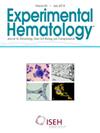Mer receptor expression promotes multiple myeloma disease development via a cell-extrinsic mechanism
IF 2.1
4区 医学
Q2 HEMATOLOGY
引用次数: 0
Abstract
Multiple myeloma (MM) is an incurable hematologic malignancy characterized by the uncontrolled proliferation of bone marrow resident plasma cells (PCs). Two members of the TAM (TYRO3, AXL, and MER) receptor family have previously been implicated in distinct aspects of neoplastic PC biology. AXL expression in MM PCs has been associated with the induction of a dormant, noncycling state within the bone marrow, whereas expression of MER has been implicated in PC proliferation and survival. Here, the generation of single TAM receptor-expressing 5TGM1 murine MM cell lines enabled the individual functional assessment of the effects of Axl and Mer receptor expression on MM development. Axl expression did not affect proliferation, cell cycling, or stromal cell-induced dormancy in vitro. Development of 5TGM1 tumors in C57BL/KaLwRij mice was also unaltered by Axl expression. By contrast, Mer expression conferred an increase in cell proliferation to 5TGM1 cells in vitro and increased 5TGM1 tumor burden in C57BL/KaLwRij mice. The protumorigenic properties of Mer were only observed following intravenous cell delivery into mice with an intact adaptive immune system. Thus, Axl is neither necessary nor sufficient for the induction of MM cancer cell dormancy, whereas MER remains a promising target for therapeutic intervention in patients with MM.
Mer受体表达通过细胞外源性机制促进多发性骨髓瘤疾病的发展。
多发性骨髓瘤(MM)是一种无法治愈的血液系统恶性肿瘤,其特征是骨髓常驻浆细胞(PCs)不受控制的增殖。TAM的两个成员(TYRO3, AXL和MER)受体家族先前涉及肿瘤PC生物学的不同方面。AXL在MM PC中的表达与骨髓内休眠、非循环状态的诱导有关,而MER的表达与PC的增殖和存活有关。本研究通过生成表达5TGM1的单一TAM受体小鼠MM细胞系,对Axl和Mer受体表达对MM发育的影响进行了个体功能评估。Axl的表达不影响体外增殖、细胞周期或基质细胞诱导的休眠。C57BL/KaLwRij小鼠中5TGM1肿瘤的发生也不受Axl表达的影响。相比之下,Mer的表达增加了体外5TGM1细胞的增殖,并增加了C57BL/KaLwRij小鼠的5TGM1肿瘤负荷。Mer的促肿瘤特性仅在静脉内将细胞注入具有完整适应性免疫系统的小鼠后观察到。因此,Axl既不是诱导MM癌细胞休眠的必要条件,也不是诱导MM癌细胞休眠的充分条件,而Mer仍然是MM患者治疗干预的有希望的靶点。摘要:多发性骨髓瘤(Multiple myeloma, MM)是一种无法治愈的浆细胞(plasma cells, pc)恶性血液病。TAM的两个成员(TYRO3, AXL和MER)受体家族先前涉及MM PC生物学的不同方面。AXL在MM PC中的表达与诱导休眠有关,而MER的表达与PC的增殖和存活有关。通过使用表达单一TAM受体的小鼠骨髓瘤细胞系,我们证明了Axl对于诱导MM癌细胞休眠既不是必要的也不是充分的,而Mer促进肿瘤的发展,并且仍然是MM患者有希望的治疗靶点。
本文章由计算机程序翻译,如有差异,请以英文原文为准。
求助全文
约1分钟内获得全文
求助全文
来源期刊

Experimental hematology
医学-血液学
CiteScore
5.30
自引率
0.00%
发文量
84
审稿时长
58 days
期刊介绍:
Experimental Hematology publishes new findings, methodologies, reviews and perspectives in all areas of hematology and immune cell formation on a monthly basis that may include Special Issues on particular topics of current interest. The overall goal is to report new insights into how normal blood cells are produced, how their production is normally regulated, mechanisms that contribute to hematological diseases and new approaches to their treatment. Specific topics may include relevant developmental and aging processes, stem cell biology, analyses of intrinsic and extrinsic regulatory mechanisms, in vitro behavior of primary cells, clonal tracking, molecular and omics analyses, metabolism, epigenetics, bioengineering approaches, studies in model organisms, novel clinical observations, transplantation biology and new therapeutic avenues.
 求助内容:
求助内容: 应助结果提醒方式:
应助结果提醒方式:


